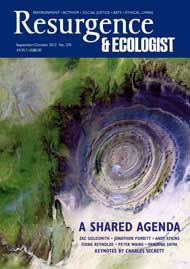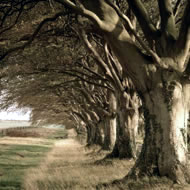Given my role with CPRE, it’s not surprising that I’m often asked just why rural England needs protecting. It is partly because of the statistic (quoted by the prime minister and others) that only 5% of England is built on – a statistic that allows developers to insist the countryside can easily accommodate much more housing and industry in the name of economic growth. Of course, the real ‘landscape footprint’ of development is much greater than the area of land covered by concrete, bricks and mortar.
Our Intrusion mapping showed that at the time of the first issue of Resurgence – 45 years ago – the area of England disturbed by the sights and sounds of development was around 25%. Now that figure is over 50%, and rising steadily, making it harder than ever to use the countryside as an escape route from the stresses of modern life. And here at CPRE we strongly believe the restorative benefits we derive from rural landscapes are just as important as the role the countryside plays in producing our food, providing biodiversity and mitigating against climate change.
This magazine’s editor, Satish Kumar, beautifully captured the essence of these benefits in his piece on Dartmoor for CPRE’s Icons of England book: “Walking in the wild is my meditation. Walking in Nature is my prayer, my peace and my solitude... I come here for the breath of fresh air, the smell of the wet grass, the coolness of water and the purity of rocks.”
Since CPRE was formed 85 years ago, we have always defended the importance of our human connections with the countryside. We celebrate the inspiration we gain from its natural beauty and sense of freedom, but the countryside is vital for health and wellbeing in other, deeper ways.
We can discover our own personal stories, creating a sense of our own belonging through the power of place. And when we step into the wilder areas of our National Parks, we can almost imagine that no one else has trodden this path – not since one of our ancestors thousands of years earlier. And there is another indefinable emotion – part relief, part pride – that humankind has left this place untouched, or at least unharmed.
Our ancestors’ hopes and fears were completely immersed by the need for food, warmth and shelter – they really were living off the landscape. To think of their struggles, and the solace they gained from the certainties of the changing seasons and the cycles of Nature – joys we can still share with them – gives an important perspective to the petty problems we may be struggling with ourselves. Their very real connection to the land gives us real roots in that same landscape – and that is why any plans to sell off ancient forests or historic landscapes generate such fury, not just amongst rural communities but equally among town and city dwellers too.
The traditionally farmed landscapes of England’s ‘picturesque’ downlands lift our spirits in other, subtler ways too. This countryside formed as the result of a benign partnership – the land fed, clothed and sheltered the people, who in return created beauty that often enhanced natural landscapes.
Why does this provide such comfort?
To see the evidence in the landscape that it is possible to work with Nature in a complementary way gives hope in our ability to create a new kind of harmony with the natural world. Perhaps, because we have seen so much bad development and disrespect for natural beauty in the last century, we feel we are looking back to a golden age. Indeed, part of the reason for CPRE’s formation in 1926 was that we had forgotten to respect Nature; it had already become a resource to exploit.
As much as we celebrate the spirituality of the countryside, we must gather evidence of the more tangible physical benefits of its natural assets. The search for tranquillity is the reason for almost half of all visits to the countryside, and medical studies have shown that natural tranquillity both helps reduce blood pressure and aids recovery from illness.
Trying to preserve what is left of this tranquillity is vital in light of recent research that now proves our cities are 10 times noisier than a decade ago.
CPRE’s pioneering work to map noise pollution has shown that tranquillity is a diminishing resource across England, with areas of deep tranquillity now reduced to small, isolated islands. We asked thousands of people to define this elusive quality: it wasn’t just ‘peace and quiet’, but included views of natural landscapes, or even the sounds of birdsong, running water and the wind in the trees.
Our visual representation of the loss of our tranquil areas has encouraged local authorities to do more to promote and protect them. The government has also pledged support for tranquillity in its latest environmental and planning policies, and it is increasingly recognised as a measure of quality of life to be considered in planning decisions. However, the real test will come with the results of the public inquiry into the expansion of Lydd Airport – a development that (we argued) would shatter the tranquillity of Romney Marsh, a rural haven of the South East.
Tranquillity at night is just as important as by day, and our long campaign against light pollution is founded on the belief that as well as wasting energy, it denies us the unequalled experience of gazing at a star-filled night sky. There is no easier way to immerse ourselves in ‘something bigger’ and escape our problems than through this glimpse of the universe. This liberating sense of insignificance is something that only Nature can provide.
We all came from the land, and we all have a desire to go back there – it is instinctive. Those connections with our ancestors going back millennia are far stronger than our connections to the steel and glass of our cities.
More than ever, we need to engage people with the landscape, so that all of us can be advocates for its protection. CPRE continues to promote the countryside in the spirit of inclusivity shown by our first president, Lord Crawford, in his still-stirring appeal of 1928: “The townsman has most to lose. The country should be his playground and holiday home. His parks and gardens in the city itself are precious beyond words, for they are in his midst and day by day give him the recreation and the inspiration of trees and grass and flowers. But the countryside with its woodlands and open fields is the real thing – the real source of repose, where our food comes from, whence our ancestors sprang.”







